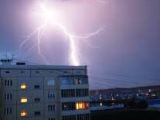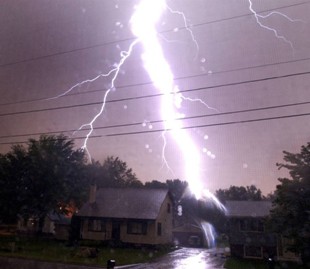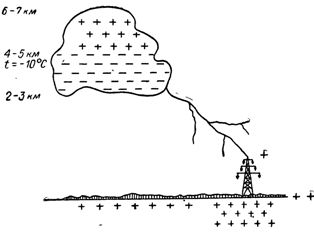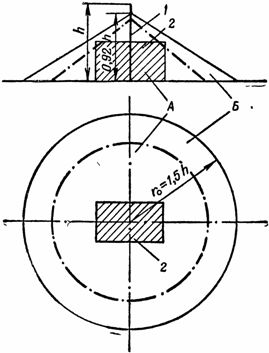Lightning protection of buildings and facilities
 Discharge of lightning from atmospheric electricity can cause insulation damage, accidents in electrical installations, accidents with people and destruction of buildings and structures.
Discharge of lightning from atmospheric electricity can cause insulation damage, accidents in electrical installations, accidents with people and destruction of buildings and structures.
The appearance of lightning
When the sun heats the earth's surface, upward air currents saturated with water vapor arise. Smaller water particles are negatively charged, larger ones are positively charged.
Under the influence of wind and gravity, a separation of oppositely charged particles occurs. Water particles in clouds that rise to a height of more than 5 km freeze and collapse. Positively charged crystals are located in the upper part of the cloud, at a height of 5-7 km, negatively charged - at a height of 2-5 km. As a result of the separation of charges in the clouds, the so-called are formed. Space charges and different parts of the thundercloud have different charge values and signs. Charges from the bottom of the cloud cause charges of the opposite sign on the ground.
Between the clouds and the ground, as well as between different parts of the cloud or between different clouds, fields of high intensity — several tens of thousands of volts per centimeter — arise. At a field strength of about 30 kV / cm, ionization of the air occurs, a breakthrough begins - the so-called leader discharge (a dimly glowing channel with a diameter of 10–20 m), moving at an average speed of 200–300 km / sec.
Under the action of the field, charges on the ground — in areas with increased conductivity (wet places, electrically conductive layers, etc.) or with high objects (hills, chimneys, water towers, poles, power lines, trees, independent buildings on the plain, etc. .) — move towards the driver.
The conductor is directed to the object in relation to which the electric field voltage is the greatest and then a powerful counter-discharge occurs, propagating at a speed comparable to the speed of light (Fig. 1). In addition, in less than one ten-thousandth of a second, a current reaching hundreds of thousands of amperes passes through the affected structure, under the influence of which the plasma heats up to several tens of thousands of degrees and begins to glow brightly.
The light effect of the ejection is perceived as lightning, and the explosive expansion of air in the exhaust channel produces a sound effect — thunder.
Rice. 1. Schematic of the process of electrification of a thundercloud and the development of a lightning discharge towards a ground object.
Measurements show that approximately 3/4 of the discharges originate from the negatively charged parts of the cloud, and 1/4 of the discharges from the positively charged areas. After the first one, several more consecutive discharges may appear.
Lightning discharges are characterized by the following parameters:
• current amplitude — the most frequently observed current is 10–30 kA, in 5–6% of measurements the current reaches 100–200 kA;
• length of the wave front — the duration of the rise of the lightning current to its maximum value (usually 1.5-2 μs).
Much less often, ball lightning is observed, which is a glowing plasma ball with a diameter of up to half a meter, slowly moving under the influence of air currents on the earth's surface. Ball lightning penetrates buildings through chimneys, windows, doors.
If ball lightning touches a living organism, there are fatal injuries, severe burns occur, and upon contact with structures, explosion and mechanical destruction of objects occur. The nature of ball lightning is still not well understood.
Impact of lightning on buildings and structures
A direct lightning strike causes splitting of supports, melting of structures, ignition and explosion, mechanical destruction, unacceptable heating of metal structures from lightning passing through them into the ground. According to operational data, lightning burns through sheet metal with a thickness of 4 mm.
Electrostatic induction manifests itself in the creation of a high potential on insulated metal structures and wires, which leads to the destruction of the ground, which in turn can cause electric shock to people, ignition and explosion of explosive mixtures, as well as damage to the insulation in electrical installations .
Electromagnetic induction manifests itself in induction during discharge current on expanded metal structures and communications (beams, rails, pipelines, etc.), isolated from each other and from the ground, which can cause a spark or arc.
In the event of a lightning discharge, high potentials are also introduced along external ground structures and communications.
Buildings and facilities, depending on their purpose and the intensity of lightning activity in the area of their location, must be protected from lightning damage or secondary effects caused by lightning discharge.
The territory from the Urals to Krasnoyarsk and to the south of Krasnoyarsk, from Krasnoyarsk to Khabarovsk belongs to areas with an average duration of thunderstorm activity of 40 to 60 hours. In the region north of Krasnoyarsk, from Krasnoyarsk to Nikolaevsk-on-Amur, the average duration of thunderstorm activity is from 20 to 40 hours. Increased thunderstorm activity from 60 to 80 hours per year is observed in the regions of Upper Altai (Biysk-Gorno-Altaysk-Ust-Kamenogorsk). Lightning protection of buildings and structures must be carried out according to projects developed by specialized organizations.
Protection against direct lightning strikes. Lightning rod coverage area
The action of lightning protection devices consists in the fact that a metal lightning rod towering over it is installed near the protected object, reliably connected to the ground. When a lightning discharge occurs, the conductor rushing to the ground approaches the highest point of increased conductivity (the upper part of the grounded lightning rod serves as such point) and the discharge occurs to the lightning rod, bypassing the protected object.
The protective zone of a single-rod lightning rod of height h is a cone of height 0.92 h with a base in the form of a circle with a radius of 1.5 h (Fig. 2).
All structures that fit into the cone will be protected from a direct lightning strike with a reliability of at least 95% (Zone B).Inside a cone with a height of 0.85 hours and a base radius of 1.1 hours, the protection reliability is 99.5%. (Zone A).
Rice. 2. Single rod lightning protection zones. A — protection zone with 99.5% reliability; B — protection zone with 95% reliability; 1 — lightning rod; 2 — protected object.
If the site area is larger than the protected area, it is necessary to increase the height of the lightning rod or install several lightning rods.

Protection against secondary effects of lightning
The main measure to combat the occurrence of high potentials in buildings or structures due to electrostatic induction during atmospheric discharges is the grounding of all conductive elements of the building.
To remove influence electromagnetic induction in elongated metal elements (pipelines, metal structures, etc.), the latter are reliably connected with metal bridges.
In order to eliminate the transfer of high potentials through aerial and underground communications, the inputs of power, radio, signaling and communication networks are implemented by cable and valve limiters (for example, RVN-0.5) and spark gaps, which are triggered when the voltage rises are installed.


